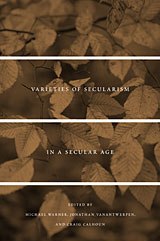 Let us recognize, from the outset, the delicious perversity of inviting comments upon comments about the comments about Charles Taylor’s A Secular Age, itself a commentary, magisterial in scope, about the inability of Anglo-Europeans to end a certain cycle of commentary about themselves, their religion, and their humanity. Nevertheless, of the many thoughtful responses and salvos found in Varieties of Secularism in a Secular Age, I was most struck by Wendy Brown’s pointed and potentially devastating piece on the shortcomings of Taylor’s “odd historical materialism.”
Let us recognize, from the outset, the delicious perversity of inviting comments upon comments about the comments about Charles Taylor’s A Secular Age, itself a commentary, magisterial in scope, about the inability of Anglo-Europeans to end a certain cycle of commentary about themselves, their religion, and their humanity. Nevertheless, of the many thoughtful responses and salvos found in Varieties of Secularism in a Secular Age, I was most struck by Wendy Brown’s pointed and potentially devastating piece on the shortcomings of Taylor’s “odd historical materialism.”
Taylor’s sense of the material world is not unrelated to his not always implicit commitment to (or perhaps nostalgia for) the ideals of a self that flourishes, unfolds, and, at the end of the day, can be sufficiently liberated from history so as to be able to take the measure of itself—in concert, of course, with others, as they liberate themselves sufficiently from those very same forces.
In “The Sacred, the Secular, and the Profane: Charles Taylor and Karl Marx,” Brown takes Taylor’s reading of Marx to the genealogical mat. Taylor, argues Brown, practices a kind of materialist analysis that replaces a focus on the processes by which historical conditions are generated with explanations of what psychologically animates human action. Consequently, in Taylor’s story the focus on motives and aims leave little room for forces that do, in fact, exist, yet are “beyond our control, and even our cognition.”
So, as I sit here, in my comfortable chair, latte in hand, a Chocolate Mini Sparkle Doughnut by my side, I wonder whether such forces are simply too much to bear. I look to the copy on my cup for guidance: “Everything we do, you do. Buy our coffee and good things happen.”
Brown homes in on what I see as a significant detail of A Secular Age—the presentation of human intentions without sufficient attribution to the vibrancy of the environmental forces that conditioned them. To be sure, there are tragic limitations at the heart of Taylor’s story. But, as Brown argues, Taylor gives lip but little service to what Brown, via Marx, calls “historical forces conditioning and contouring secularism that do not take shape primarily as ideas or explicit human aims.”
Capitalism, to take but the most pertinent example, does not exist in essence yet possesses an agency of its own. “The movement of capital,” writes Brown, “violates both the creation of man (species being) and human capacity and creativity (making what we will of ourselves)—it violates holiness and humanism at once. Capital’s profaning power blasphemes human divinity and inverts the proper order of things, reducing us to its effects.” Capitalism is religious (and not simply like religion) precisely because of this unlocatable agency. Transgression follows in its wake, the only mark of its existence, portending a general state of enchantment. Capitalism disrupts all manner of binaries, profaning both human being and potential, transforming the best of Enlightened intentions into all manner of benevolent stasis and bloodless alienation.
Taylor, of course, is not alone in his failure to follow through on the more radical implications of Marx’s argument. Marx didn’t either, positing a heroic, ultimately expressive consciousness as the inheritance of a redeemed humanity that would make its way across a threshold of false consciousness, beyond capitalism.
But whither redemption when it has become all but impossible to come to terms—any terms whatsoever, mind you—with “forces” that are “humanly generated but not apprehended as such and not humanly controlled”? This is not any garden-variety illusion, but rather a particular kind of hallucination that is endemic to the secular age. This hallucination, moreover, is bound up with capitalism but cannot be reduced to mere economics. For it thrives in any space that entertains the outrageous perspective that opacity and enchantment can, with epistemic diligence (and a politics that promotes such diligence), be overcome.
Indeed, it would take someone like Walter Benjamin, stoned observer of modernity’s ambiguous core, witness to both the beauty and violence of capitalistic structures, to begin to take seriously the ontology of self-organizing economic and political systems. And it is this genealogical move that Taylor’s narrative refuses. In rendering enchantment as a pre-existing but unnecessary condition (and transparency as a kind of ideal), Taylor misses something definitive about the secular age whose story he is telling.
Summarizing (by way of a Benjaminian lineage of critique that addresses the phantasmic elements of modernity) what might be called the genealogical insight of Marx, Brown writes that humans are “extraordinary creatures, capable of endowing our mental and physical productions with autonomy, generativity, even sovereignty.” Once such sovereignty is entertained, the line of questioning posed by Taylor calls for a different kind of explanatory response. It requires a more meticulous, yet vaguer, documentation. It demands a history of modernity that does not simply jettison naïve theories of secularization (as Taylor’s admirably does), but that also gestures toward the norms of enchantment and opacity. Regrettably, such states are often assumed to be exceptional, existing only to prove other rules. This point, I think, is at the heart of Jane Bennett’s subtle critique of Akeel Bilgrami’s discussion of enchantment vis-à-vis Taylor’s use of it in A Secular Age.
Brown’s story of the secular age would begin with a different premise. The questions would be genealogical rather than analytic: How is the “secular subject to be grasped and articulated,” asks Brown, given that each one of our decisions may be our own even though the range of available choices has nothing, whatsoever, to do with us? “How is its history to be traced, what are the most relevant conditions of its emergence, and what kind of consciousness is secular religious consciousness?”
Such questions inevitably turn the narrative logic of A Secular Age against itself, for they necessarily call attention to what is embedded deep within the structures of Taylor’s argument—namely, the communicative promise of liberalism, its imagined harmony of differences, and of course, a tolerant embrace of “alternative” notions and lifestyles.
In opening her essay with a discussion of the Obama campaign and the resurgence of a “spiritual left” in 2008, Brown positions Taylor’s work as partaking in a similar project of hope—of affirming “belief in belief.” And who amongst us was not just a little hopeful when envivsioning an Obama administration? But what, exactly, was that hope about? Perhaps the same as that which gives A Secular Age its sense of welcome gravitas.
We have here, in two sites, the presence of a vague yet generative epistemics that serves, not to legitimate this or that doctrine, but to secure the kind of self who could assent to a doctrine if he or she only chose to do so.
For at the end of the day, Taylor’s story of the nova effect of choice vis-à-vis the concept of religion is premised upon a self that has the potential to fulfill such promises and fuel such harmonic processes in and through its inherent sovereignty and its capacity for immediate access to itself and the world around.
Brown broaches a question that confirms the deeply romantic genre in which Taylor tells his tale. The question is not whether Taylor’s is a great work. Nor, really, is the question about whether Taylor is right or wrong. It is, rather, a question of narrative effects. For, as the image on the cover conveys, an iron bridge of Whitmanic expanse is displacing the more dystopic iron cage.
The question—for me, at least—is to what extent the fragments of Taylor’s argument constitute a strategy of defense, shored against the ruins of history and society itself? A strategy of immunization? Of disenchantment in its classic Weberian formulation? A fixing of the distinction between subject and nature? A desire to immobilize nature, chance, and secrecy? A product, in other words, of the secular age it promises to describe?
* * *
Brown’s essay points to how, within Taylor’s narrative, enchantment and opacity exist for the purpose of being transcended—spectral forces ultimately succumbing to diligence and intention.
Another text, from Marx’s scene of writing, also speaks to this kind of relationship between reason and enchantment: On Hallucinations: A History and Explanation of Apparitions, Visions, Dreams, Ecstasy, Magnetism, and Somnambulism (1845), by A. Brière de Boismont, M.D. This founding text in the history of psychology was translated into English in 1860, when it, like numerous other scientific exposes of occult phenomena, was nevertheless embraced by burgeoning metaphysical movements on both sides of the Atlantic. (But that is another story.)
What concerns me here is de Boismont’s claim that hallucinations may “coexist with the due exercise of the reason.” Images, ghosts, specters (ethereal powers not unlike Marx’s commodities) were “creations of the mind.” And because they were “the result of things that have passed,” they were “visible to the external senses.” Yet despite their empirical veracity, hallucinations were ultimately harmless. For even when they were “looked upon as the effects of a supernatural power,” hallucinations did not pose a vital threat. De Boismont’s translated voice was emphatic, drawing on Honoré Aubanel’s Essai sur les Hallucinations (1839): hallucinations could “exist in man without the intellect being distorted.”
Hallucinations, in other words, did not necessarily constitute mental distortion. Such imbalance, on the contrary, was the effect of an overbearing reason. When reason was excessively present, the “mind” became an “obedient slave.” Consciousness lost perspective upon its own shaky ground. Reason forgot that it, too, was born of feverish dreams, that it, too, was historically conditioned—born of physical sensations, ideological vectors, and lingering emotional streams.
More reason would not necessarily solve the problem (and could, perhaps, even exacerbate it). De Boismont’s concern, then, was how one lived with hallucinations, how one disciplined oneself in light of them. Reason was to be continually sharpened through willed distortion.
The ideal, according to de Boismont, was someone like Newton who could produce hallucinations “at his pleasure.” Newton, it was said, learnt such discipline when he spent “some time” looking at “an image of the sun in a looking-glass” and then “direct[ed] his eyes towards the dark part of the room, to see a specter of the sun reproduced bit by bit until it shone with all the vividness and all the colors of the real object.” Newton’s was a project of auto-enchantment whose discipline was a matter of separating oneself from the hallucinations one had generated for oneself—like becoming an addict in order to kick the habit. An act of both self-deception and honest truth-seeking.
So what happens when reason is recognized as, in part, hallucinatory? What happens when you stop fooling yourself that spectral forces do not exist because they should not exist, that false consciousness is only a possibility precisely because it is false—at the end of the day, a state that is anathema to the better part of human nature? What happens, in other words, when enchantment is considered the norm? When claims of disenchantment are considered forms of wishful, perhaps even animistic, thinking?
So what, exactly, is the payoff of Brown’s critique of Taylor, besides getting a sense of Marx’s scene of writing, the topic of reasonable hallucinations, and the subtleties of false consciousness? What might we learn about the secular age if we were to resist the sense of intentionality that Taylor harbors? And, finally, why has it been relatively difficult to maintain a sense of refusal when assessing whatever it is we are talking about when we talk about the secular age?
Read “The sun shone fiercely through the window at Starbucks (Part II).”











